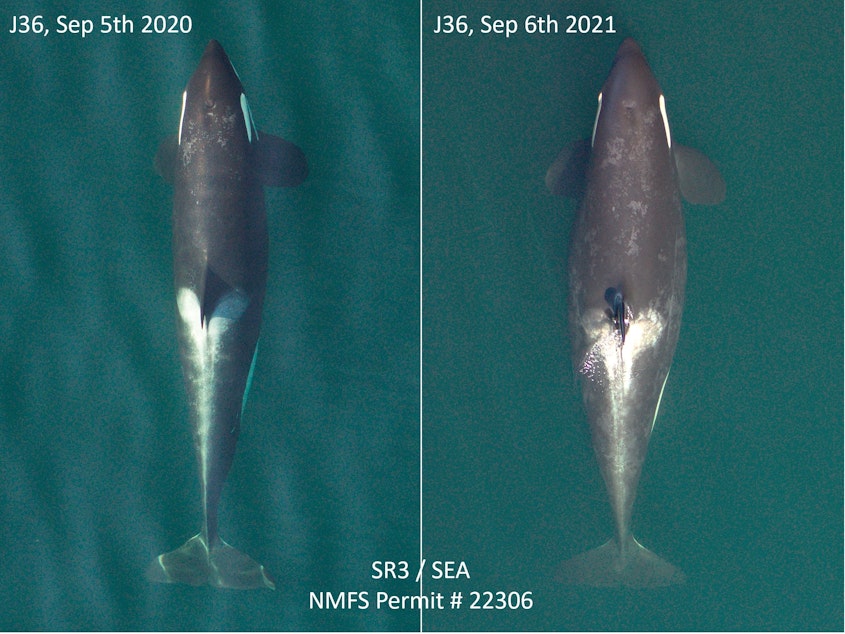Babies on board! Three endangered Northwest killer whales look very pregnant in aerial photos

Research photos taken with a drone show multiple killer whales are close to giving birth in one of the Pacific Northwest's critically endangered pods. The late-stage pregnancies stirred excitement among whale watchers -- and also renewed worries about the availability of adequate food supply for the mothers and babies.
The husband-and-wife research team of Holly Fearnbach and John Durban established that three orcas in J-pod are very pregnant while performing ongoing monitoring of Southern Resident killer whale body conditions using a drone flown high overhead. Comparison of photos taken of the three female orcas earlier this month versus last year revealed unmistakable bulges in their midsections. The pregnant females are J36 (Alki), J37 (Hy'Shqa) and J19 (Shachi), who is 42-years-old and already a grandmother twice over.
The pregnancies raise hopes of turning the tide and slide toward extinction of an iconic species in the Northwest.
"This hope, however, is fragile," Durban said. "Last year, we documented a number of other pregnant females, who were not successful in rearing calves. Unfortunately, this is not unusual and we have documented a high rate of reproductive failure over the last decade."
A research biologist at NOAA's Northwest Fisheries Science Center who studies pregnancies in orcas, dolphins and porpoises said the calves generally have around a 50 percent chance of surviving into adulthood.
"I am personally cautiously optimistic," said Dawn Noren. "These three individuals have had previous calves so that's a little reason to be optimistic. There are concerns with food consumption, of course."
Chinook salmon are the preferred food of the Pacific Northwest's resident orcas and many of those salmon runs are also on the endangered or threatened species lists.
"When they have their calves, they will need a lot more food when they are producing milk to feed them," Noren continued. "One-and-a-half to two times their normal prey requirements."
Noren said she was also concerned that the orca mothers could transfer toxic pollutants accumulated in their fat to their offspring while nursing. Legacy contaminants in the marine environment -- such as DDT, PCBs and PBDE -- can potentially cause neurological harm in newborns.
J-pod previously had a "baby boom" in 2015-16 during which six whales were born, of which only two are still alive (J51 Nova and J53 Kiki). Longtime Salish Sea orca expert Ken Balcomb of the Center for Whale Research wrote after the death of J52 that the poor survival rate was most likely due to malnutrition. Juvenile orcas can also be felled by illnesses or infections when their immune systems are weakened.
In reaction to the newly discovered orca pregnancies, the Washington Department of Fish and Wildlife increased the distance whale watch boats need to stay away from the "vulnerable" animals. Commercial vessels now have to stay at least a half-mile away from the pregnant orcas to give them more room to forage undisturbed, which will hopefully lead to successful births.
"Professional whale watchers will be giving the expectant moms extra space if they are encountered in the area, and we'd like to encourage *all* Salish Sea boaters to please do the same," said the cross-border Pacific Whale Watch Association in a Facebook post late Monday. "While we always meet Southern Resident pregnancy announcements with guarded optimism, each one offers renewed hope."
Following the presumed death of K21 (Cappuccino) in late July, the endangered resident orca population currently sits at 74 individuals. The three pods in this population of fish-eating orcas have struggled to grow amid the trio of pressures: lack of prey, environmental contaminants and human disturbance from vessel traffic and underwater noise.
By contrast, a separate, overlapping population of Bigg's killer whales is thriving and now more commonly seen by Salish Sea whale watchers. The Bigg's killer whales, sometimes called "transients," feed on marine mammals such as abundant harbor seals and sea lions. These stealthy orcas do not vocalize or echolocate like their Southern Resident cousins do.
[Copyright 2021 Northwest News Network]

